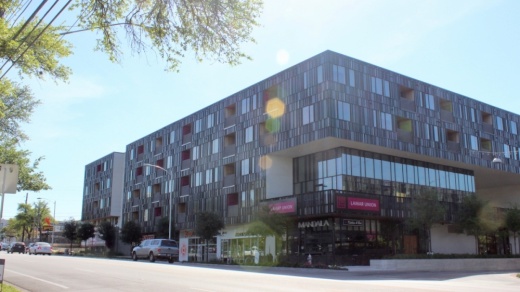Council members workshopped one concept nearing the finish line, an expansion of the city’s vertical mixed-use, or VMU, affordable development program, during a May 31 housing committee meeting. The VMU change would create a new category within the program that offers development incentives such as increased height in exchange for affordable housing. Proposed by District 5 Council Member Ann Kitchen late last year, an update called VMU2 would increase the allowed height for participating projects if more affordable units are offered.
According to city housing staff, VMU has proven to be one of Austin’s most successful development incentive programs, second only to the University Neighborhood Overlay, which has spurred denser construction in the West Campus area. Hundreds of affordable spaces have been added under VMU in recent years out of the nearly 6,800 total housing units built through the program so far, and more than 1,000 of the more than 8,900 VMU units either under construction or in planning will also be available at an affordable level.
“We’re not talking about enhancing a program that hasn’t worked. We’re talking about taking a program that’s been successful and shown us that it can be successful and making it that much more successful," Kitchen said. Even with that relative success, staff noted the program still has some drawbacks. As with many other such programs, VMU’s affordability levels are based on regional median family income, or MFI, levels that do not account for all local residents equally. U.S. Census Bureau data shows that Latino and Black Austinites' annual earnings fall around $20,000 to $25,000 below the local MFI, while white and Asian residents earn around $15,000 to $20,000 above that mark, meaning affordability as measured by MFI can often remain out of reach.
Planner Sam Tedford also said despite the extent of VMU-zoned properties along Austin’s main transit corridors, only around one-third of development on that land actually comes through the VMU program, a figure she labeled as a “pretty small” amount given available incentives. Tedford also noted Austin's compatibility limits—regulations enacted to protect older, residential areas by restricting new development nearby that are among the strictest of all major U.S. cities—hamper developers' ability to build as tall as the program allows.
“Less than half of our VMU-zoned sites can even reach their base height entitlement because of compatibility standards," Tedford said.
Worries about the program's limited usage are also shared by community members, including Chris Affinito, Heartwood Real Estate Group president, who told council members he believes the proposed VMU2 revision will not reach its potential.
“This proposal does not go far enough to actually create more density, especially on these corridors," Affinito said. "If we actually want to be able to add a significant amount of new housing units that we weren’t able to add before, I think that we need to take this a step further.”
Other proposals
Following its review May 31, the council housing committee voted 3-0-2 in favor of amendments to VMU2 brought by District 4 Council Member Chito Vela to extend its potential effect. Those changes would reduce compatibility triggers and cut the amount of required parking along Project Connect rail lines.
On council's message board, Vela said he brought the amendments to address affordability and environmental concerns as the new transit system rolls out and to "build confidence" ahead of other policy discussions regarding major corridors. Kitchen also said council should take on the compatibility tweaks for VMU2 ahead of those broader talks along with consideration of additional affordability requirements in the measure.
“This VMU document was never intended to change compatibility; that was going to happen in another document, ... but I do agree with Council Member Vela that if we make at least some of the compatibility changes in this ordinance, we can get them going right away. It’s not an either/or," she said. "We should push the envelope a bit more in terms of getting as much affordability as we can.”
Kitchen has already offered an increased amount of affordable housing required for VMU2 projects with 15% of rental units available at 60% MFI and below, or 12% of all rental spaces if available at a lower 50% MFI limit. Ownership projects such as condominiums would have affordability set at 12% of all units at 80% MFI.
In addition to VMU2, council next week will be voting on a broader update to development regulations along Austin’s “large” and “medium” corridors, as defined by a working group of city officials who took on the policy update.
The passage of that item would launch possible code amendments aimed at several compatibility limits and triggers along such corridors for new developments as well as cutting parking requirements for those projects.
Another resolution from District 6 Council Member Mackenzie Kelly and co-sponsored by Council Members Vela, Kitchen, Paige Ellis and Natasha Harper-Madison would streamline the city's regulation of accessory dwelling units, or ADUs. That process could also open the door to ADU construction where it is not allowed. Council voted to make ADU construction easier and more widely available throughout the city during previous housing discussions late last year.





